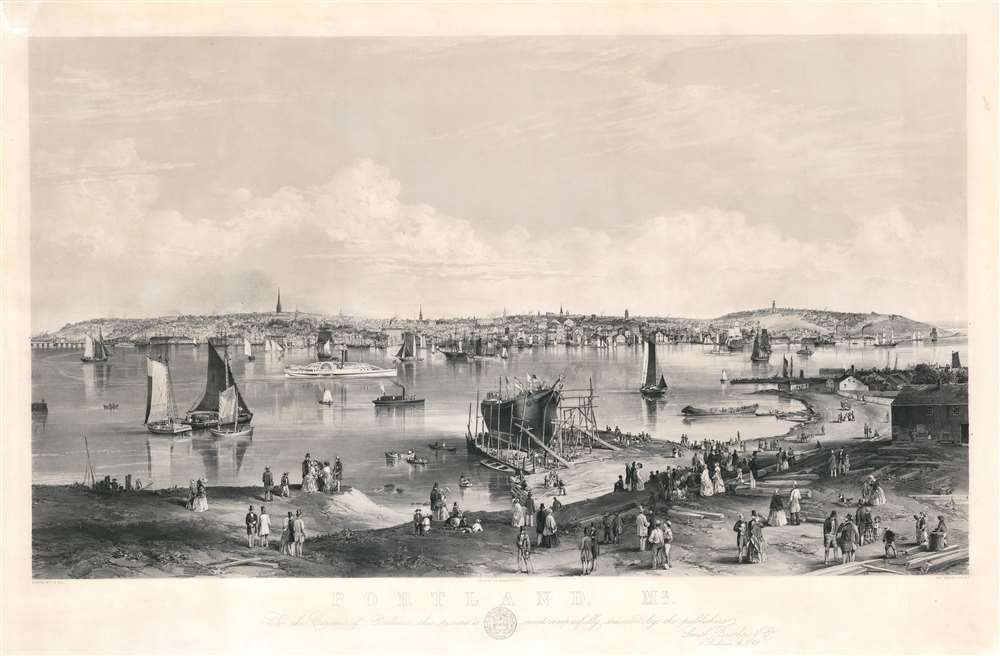This item has been sold, but you can get on the Waitlist to be notified if another example becomes available, or purchase a digital scan.
1855 John William Hill Panoramic View of Portland, Maine
PortlandView-hill-1855
Title
1855 (undated) 28 x 42.5 in (71.12 x 107.95 cm)
Description
Publication History and Census
This map is based upon a painting by John William Hill, now lost. It was engraved by Charles Parsons Lithography of New York, and printed by Endicott and Company. The view was published by the Smith Brothers under the management of Benjamin Franklin Smith, 59 Beekman St. Although we are aware of only one edition by Smith, published as here in 1855, the view was greatly admiring in its day and plagiarized in smaller modified formats by other publishers. Curiously, the OCLC identifies only one institutional holding, at Harvard, however, we are aware of at least 3 others of this first edition in private hands.CartographerS
John William Hill (January 13, 1812 – September 24, 1879) is a British-American landscape, still life, and view artist based primarily in New York City. Hill born in London, the son of aquatint engraver, John Hill. His family emigrated to the United States, settling in Philadelphian, in 1819. In 1822, they relocated to New York and opened an aquatint shop, at which J.W. Hill began an apprenticeship. In his early twenties, Hill began work for the New York State Geological Survey, producing topographic studies and overhead views of American cities and towns. There he developed a flair for rendering minute architectural detail and creating highly accurate perspectives. By the 1850s Hill embraced Pre-Raphaelite panting styles and represented that school in the United States. He was a founding member of the Society for the Advancement of Truth in Art. More by this mapmaker...
Endicott and Company (fl. c. 1828 - 1891) was a New York based family run lithography firm that flourished throughout the 19th century. The firm was founded by George and William Endicott, brothers who were born in Canton, Massachusetts. George Endicott (June 14, 1802 - 1848) trained as a lithographer under Pendleton Lithography from January 1826. He later worked as superintendent of Senefelder Company until the summer of 1828. Afterwards, in 1830, he relocated to Baltimore and partnered with Moses Swett. Endicott and Swett relocated to New York City in December 1831. They remained partners until July 1834 when the relationship dissolved. George set up shop on his own account at 359 Broadway. William Endicott (1815 - 1851), George's younger brother of 14 years, joined the firm in 1840 and was made a partner in 1845, after which the name of the firm was changed to G. and W. Endicott. George Endicott died shortly afterward, in 1848, but William continued operating the firm as William Endicott and Co. until his own 1851 death at just 35 years old. The firm was carried on by his widow Sara Munroe Endicott until it was taken over by her son, Francis Endicott, who ran the firm from 1852 to 1886. George Endicott, Jr. subsequently ran the firm from 1887 to 1891. Peters, in his important work on American lithography America on Stone writes 'it is hard to summarize the Endicotts. They did everything and did it well . . . [they] worked with and for Currier and Ives, yet in spite of all that much of their work lacks real individuality.' The Endicott firm was responsible for many 19th century views and plans of New York City and state as well as plans of Sacramento, California, and the Midwest. Learn More...
Benjamin Franklin Smith (1830 – 1927) was an artist, printer, and publisher of American city views active in the mid to late 19th century. Smith was born in South Freedom, Maine where he grew up on the family farm. His work is most commonly associated with his brothers, all of whom worked in the view-making industry, publishing both individually and separately as Smith Brothers. His brothers were Francis Smith, George Warren Smith, and David Clifford Smith. Among the brothers Benjamin, the youngest, was the most artistic, producing views as early as 1846, when he was 16. He drew his first city view, Albany as seen from the Hudson, at 17. Benjamin and his brothers initially worked as sales agents for viewmaker Edwin Whitefield. In 1849, the Smiths broke with Whitefield and began publishing under their own imprint, Smith Brothers. Benjamin Franklin drew at least four of the Smith Brother's views, and possibly significantly more. Reps suggests that the firm stopped publishing in 1855, but at least two important views, the 1857 Smith-Hill-Mottram view of Boston and the 1862 Smith view of Elmira, were issued later. Although both bear the Smith Brothers imprint, they were copyrighted by Benjamin Franklin Smith and are more likely than not, unassociated with the other brothers and their earlier views. In any case, the Smith firm was sold at an enormous profit in 1855, making the family extremely wealthy. They furthered their fortunes by investing in railroads. At the time of his death in 1927, Benjamin Franklin Smith was believed to be the richest man in Maine. Learn More...
Charles Parsons (1821 - November 9, 1910) was an American artist and lithographer active in New York. Parsons was born in Hampshire, England in 1821. He emigrated to the united States at 9, apprenticing as a lithographer under George Endicott from 1833. Parsons produced numerous views and lithographs for Endicott and Company, but also engraved or Nathaniel Currier, later Currier and Ives. In 1863 he became the art director for Harper’s Publishing, a position he held until 1889, when he retired. Parson's was influential in the development of American illustration and lithography. His son, Charles R. Parsons, was also an artist based first in Manhattan, then Brooklyn. Learn More...

